How much is a vibrating screen
The price of a vibrating screen can vary depending on several factors such as the size of the screen, the type of screen, the materials used in its construction, and the manufacturer or supplier. In general, a basic vibrating screen for small-scale operations can cost anywhere from a few hundred to several thousand dollars.
For larger-scale operations, the price of a vibrating screen can range from several thousand to tens of thousands of dollars, depending on the size and complexity of the equipment. High-end vibrating screens used in industrial applications can cost even more.
Vibrating screens are widely used in various industries for the screening and grading of materials. Some common applications of vibrating screens include:

Mining and Quarrying
Vibrating screens are commonly used in the mining and quarrying industries to separate materials based on size or particle shape. They are also used for dewatering and desliming of mineral concentrates.
Aggregate Processing
Vibrating screens are used in aggregate processing to separate materials such as sand, gravel, and crushed stone based on size.
Chemical Processing
Vibrating screens are used in chemical processing to separate and classify chemicals based on particle size and density.
Food and Beverage
Vibrating screens are used in the food and beverage industry to separate and classify food products based on size, shape, and other properties.

Recycling
Vibrating screens are used in recycling facilities to separate and classify recycled materials based on size and density.
Pharmaceuticals
Vibrating screens are used in the pharmaceutical industry to separate and classify pharmaceutical products based on particle size and shape.
Overall, vibrating screens are an essential piece of equipment for many industries, and their versatility and efficiency make them suitable for a wide range of applications.
It is important to note that the price of a vibrating screen is not the only factor to consider when purchasing one. Other factors to consider include the quality of construction, the durability of the equipment, the after-sales service provided by the manufacturer or supplier, and any additional features or accessories that may be required for specific applications. It is recommended to compare prices and features of different models from different manufacturers or suppliers before making a purchasing decision.



